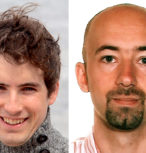DNA reveals the past and future of coral reefs
New DNA techniques are being used to understand how coral reacted to the end of the last ice age in order to better predict how they will cope with current changes to the climate. James Cook Univer

From 2005 to 2022, the main node of the ARC Centre of Excellence for Coral Reef Studies was headquartered at James Cook University in Townsville, Queensland (Australia)








Abstract:
Connectivity between coral reefs is critical to ensure their resilience and persistence against disturbances. It is driven by ocean currents, which often have very complex patterns within reef systems. Estimating coral connectivity over large systems composed of hundreds of reefs is a very complex task that can hardly be addressed with observations alone. Biophysical models that simulate both the ocean currents and the life-history traits of larvae transported by these currents can fill this gap. However, biophysical model results critically depend on the spatial resolution at which ocean currents can be simulated. Here we use the high-resolution unstructured-mesh coastal ocean model SLIM to model coral connectivity in both the Great Barrier Reef (GBR) and the Florida Reef Tract (FRT) up to a spatial resolution of about 100m. By using different connectivity measures and clustering methods, we can highlight the fine-scale details of the connectivity pathways. We then introduce new indicators, based on the PageRank algorithm, to identify reefs that should be protected in priority and those that are best suited to coral restoration projects. Such a fine-scale information can provide knowledge-based decision support to allocate conservation and restoration resources optimally.
Biography:
Antoine Saint-Amand holds a Master in Bioscience Engineering degree from UCLouvain (Belgium) and is currently doing a PhD. Antoine works on multi-scale connectivity modelling with the ocean model SLIM. His supervisor, Emmanuel Hanert, is professor at UCLouvain. Before moving back to Belgium, Emmanuel was a lecturer at the University of Reading (UK) in the Departments of Mathematics and Meteorology. He is interested in the development and application of multi-scale ocean circulation models.
New DNA techniques are being used to understand how coral reacted to the end of the last ice age in order to better predict how they will cope with current changes to the climate. James Cook Univer
A new study on the effects of climate change in five tropical countries has found fisheries are in more trouble than agriculture, and poor people are in the most danger. Distinguished Profess
James Cook University researchers have found brightly coloured fish are becoming increasingly rare as coral declines, with the phenomenon likely to get worse in the future. Christopher Hemingson, a
Researchers working with stakeholders in the Great Barrier Reef region have come up with ideas on how groups responsible for looking after the reef can operate more effectively when the next bleaching
Abstract: As marine species adapt to climate change, their heat tolerance will likely be under strong selection. Individual variation in heat tolerance and its heritability underpin the potential fo
Abstract: The Reef Ecology Lab in KAUST’s Red Sea Research Center explores many aspects of movement ecology of marine organisms, ranging from adult migrations to intergenerational larval dispersal
Abstract: Macroalgal meadows are a prominent, yet often maligned component of the tropical seascape. Our work at Ningaloo reef in WA demonstrate that canopy forming macroalgae provide habitat for ad
Abstract: Sharks are generally perceived as strong and fearsome animals. With fossils dating back at least 420 million years, sharks are not only majestic top predators but they also outlived dinosa
Abstract: Connectivity plays a vital role in many ecosystems through its effects on fundamental ecological and evolutionary processes. Its consequences for populations and metapopulations have been
Abstract: Evolution of many eukaryotic organisms is affected by interactions with microbes. Microbial symbioses can ultimately reflect host’s diet, habitat range, and even body shape. However, how
Abstract: The past few years have seen unprecedented coral bleaching and mortality on the Great Barrier Reef (GBR) but the consequences of this on biodiversity are not yet known. This talk will expl